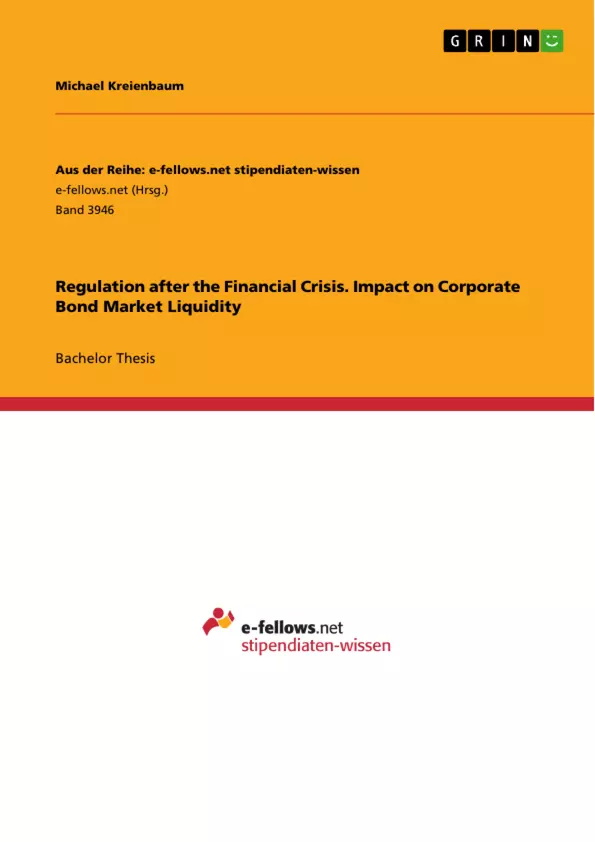This paper aims to answer the question of whether post-crisis regulatory interventions caused a decline in liquidity. To serve this purpose, it investigates how individual provisions affect the market making business and how the corporate bond market changed in response to regulations. The paper approaches the issue by structuring theoretical and empirical evidence of corporate bond liquidity. It develops regulations impact levels from particular to aggregate, facilitating a perspicacious analysis. Important to note, the study attempts to assess neither welfare effects nor the desirability of regulations.
After the financial crisis, regulators intervened to enhance the resilience of the banking system. Their provisions range from capital and liquidity standards to the prohibition of single activities considered too risky. However, concerns arise that post-crisis regulations harm liquidity by imposing constraints on its providers. When liquidity is low, investors that want to trade large volumes must wait for counterparties or accept to trade below market prices. Therefore, in certain financial markets like that for corporate bonds, intermediaries emerged to facilitate market functioning. They enable investors to trade immediately, reconciling imbalances in supply and demand.
Illiquidity is costly for the economy as investors require compensation for holding riskier bonds. Amihud and Mendelson provide cross-sectional and time-series evidence of the resulting illiquidity discount. Hence, if regulations reduced liquidity, they would cause a depreciation of prices. Also, lower liquidity implies higher cost of debt and transaction costs, as well as a less efficient resource allocation. The regulatory impact on liquidity is, therefore, highly important for policymakers and investors.
Inhaltsverzeichnis (Table of Contents)
- 1. Introduction
- 2. Liquidity provision in equity and corporate bond markets
- 2.1. Equity markets
- 2.2. Corporate bond markets
- 3. Post-crisis regulatory provisions
- 3.1. Basel 2.5
- 3.2. Basel III
- 3.3. The Volcker Rule
- 4. First-order impact on dealer liquidity provision
- 4.1. The business model of market makers.
- 4.2. Channels of regulatory impact
- 4.3. Foundations of contemporary literature
- 4.4. Evidence of the regulatory impact on traditional dealers
- 5. Changes in market structure and behavior
- 5.1. Second-order effect (1): Shift from principal trading to matchmaking
- 5.2. Second-order effect (2): Migration of market making to non-bank dealers
- 6. Evidence of aggregate corporate bond market liquidity
- 6.1. Price-based liquidity measures
- 6.2. Trading-based liquidity measures
- 6.3. Liquidity under stress
- 7. Conclusion
Zielsetzung und Themenschwerpunkte (Objectives and Key Themes)
This paper investigates the impact of post-crisis regulations on corporate bond market liquidity. It aims to determine whether these regulations have caused a decline in liquidity and explores how specific provisions affect market making activities and the overall structure of the corporate bond market.- The impact of post-crisis regulations on corporate bond market liquidity
- The effects of regulations on the business model of market makers
- Changes in market structure and behavior in response to regulations
- The measurement of corporate bond market liquidity
- The role of bank-affiliated dealers in liquidity provision
Zusammenfassung der Kapitel (Chapter Summaries)
- Chapter 1: Introduces the topic of post-crisis regulations and their potential impact on market liquidity, highlighting the importance of liquidity for investors and the economy. It outlines the research question and the scope of the study, focusing on the U.S. corporate bond market.
- Chapter 2: Provides a background on liquidity provision in both equity and corporate bond markets, explaining the role of intermediaries and the challenges associated with illiquidity.
- Chapter 3: Discusses key post-crisis regulatory provisions, including Basel 2.5, Basel III, and the Volcker Rule, outlining their impact on bank-affiliated dealers.
- Chapter 4: Explores the first-order impact of regulations on dealer liquidity provision, examining the business model of market makers, the channels of regulatory impact, and the existing literature on this topic.
- Chapter 5: Analyzes the second-order effects of regulations on market structure and behavior, focusing on the shift from principal trading to matchmaking and the migration of market making to non-bank dealers.
- Chapter 6: Provides empirical evidence on aggregate corporate bond market liquidity, examining price-based and trading-based liquidity measures and liquidity under stress.
Schlüsselwörter (Keywords)
This research paper focuses on the impact of post-crisis regulations on corporate bond market liquidity. Key terms include: post-crisis regulation, corporate bond market liquidity, market makers, Basel Accords, Volcker Rule, liquidity provision, illiquidity, price-based liquidity measures, trading-based liquidity measures, dealer business model, market structure changes.- Citation du texte
- Michael Kreienbaum (Auteur), 2020, Regulation after the Financial Crisis. Impact on Corporate Bond Market Liquidity, Munich, GRIN Verlag, https://www.grin.com/document/1128191



